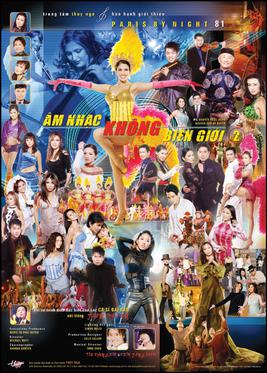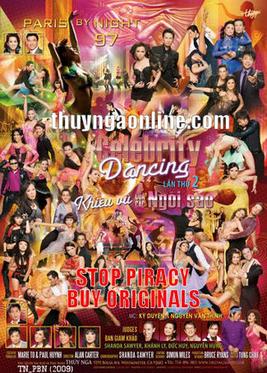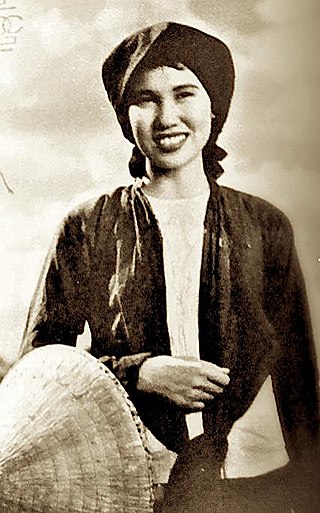Australia is home to several large immigrant communities from every continent in the world.
Australia is home to several large immigrant communities from every continent in the world.
Gamelan has been part of the music of Sydney since at least 1985, when gamelan instruments were purchased by the Centre for Performance Studies at the University of Sydney and the Australian Museum. The Sydney University Gamelan Society was founded the following year; this was followed by a student group in 1992, Kyai Kebo Giro. [1]
Vietnamese-Australian music includes tân nhạc, a form of popular music that has been part of the music of Vietnam since the late 1930s. Elements of the vocal style, such as the use of vibratos and bent tones, are common Vietnamese techniques, while Western meter, rhythms, tonal harmony, temperament and song form (ABA) are also used . Ensembles are generally made up of electric guitars, keyboards and a drum kit. Rhythms often used Latin or European dance rhythms like the tango, cha cha cha, waltz or bolero. [2] In addition to ordinary Western pop and rock, Vietnamese-Australian popular music includes the Quê hương style which often uses more traditional Vietnamese elements like the pentatonic scale, call-and-response and pieces of folk songs. The Tân cổ giao duyên is a song style that developed in Saigon in 1964, developed by Bảy Bá. It was a combination of Western popular music and a traditional song Vọng cổ. [2]
Vietnamese Australians hold large variety shows called đại nhạc hội, which are an important part of the ethnic music scene. Vietnamese-American performers sometimes attend. There are also Vietnamese chamber choirs, such as Hương Xưa and Ðàn Chim Việt in Melbourne. [2]
Vietnamese Australian folk music includes both traditional Vietnamese styles as well as Anglo-Celtic style folk music, and, very often, a mixture of the two. Vietnamese chamber music, in two styles, nhạc Huế and đờn ca tài tử, Buddhist chants and sung poetry, Ngâm thơ are performed in the Vietnamese community. The cải lương is an important Vietnamese Australian tradition; it is a form of theatre that is performed at various holidays and celebrations. [2]
The Vietnamese-Australian community has produced a number of composers who experiment with mixtures of Vietnamese and Western elements. These include Lê Thị Kim, Hoàng Ngọc Tuấn, Ðặng Kim Hiền and Lê Tuấn Hùng; others, like Bamboo Ochre and Nguyễn Anh Dũng, use elements of jazz in their work. [2]

Gamelan is the traditional ensemble music of the Javanese, Sundanese, and Balinese peoples of Indonesia, made up predominantly of percussive instruments. The most common instruments used are metallophones and a set of hand-drums called kendang, which keep the beat. The kemanak, a banana-shaped idiophone, and the gangsa, another metallophone, are also commonly used gamelan instruments on Bali. Other notable instruments include xylophones, bamboo flutes, a bowed string instrument called a rebab, and a zither-like instrument called a siter, used in Javanese gamelan. Additionally, vocalists may be featured, being referred to as sindhen for females or gerong for males.

Traditional Vietnamese music encompasses a large umbrella of Vietnamese music from antiquity to present times, and can also encompass multiple groups, such as those from Vietnam's ethnic minority tribes.

The music of Suriname is known for kaseko music, and for having an Indo-Caribbean tradition.
Lê Tuấn Hùng is an Australian-Vietnamese composer, performer, and musicologist. He is a multi-instrumentalist with a strong background in Vietnamese traditional music and Western classical music. Known as a skilled performer of the đàn tranh, a Vietnamese zither, he plays traditional Vietnamese music as well as cross-cultural and experimental music. His compositions have been created for a wide range of instruments, ensembles and media. A number of his compositions combine Vietnamese instruments with Indonesian and European Renaissance and Medieval instruments.

Kroncong is the name of a ukulele-like instrument and an Indonesian musical style that typically makes use of the kroncong. A kroncong orchestra or ensemble traditionally consists of a flute, a violin, at least one, but usually a pair of kroncongs, a cello in Pizzicato style, string bass in pizzicato style, and a vocalist. Kroncong originated as an adaptation of a Portuguese musical tradition, brought by sailors to Indonesian port cities in the 16th century. By the late 19th century, kroncong reached popular music status throughout the Indonesian archipelago.

Tuồng cải lương often referred to as Cải lương, roughly "reformed theater") is a form of modern folk opera in Vietnam. It blends southern Vietnamese folk songs, classical music, hát tuồng, and modern spoken drama.

Paris By Night 81: Âm Nhạc Không Biên Giới 2 is a Paris By Night program produced by Thúy Nga Productions that was filmed at the Terrace Theater at the Long Beach Convention and Entertainment Center in California on Saturday, January 21, 2006, the first show of 2006. It is a direct continuation of Paris By Night 62: Âm Nhạc Không Biên Giới, that was released at the end of 2001.

Phạm Duy was one of Vietnam's most prolific songwriters with a musical career that spanned more than seven decades through some of the most turbulent periods of Vietnamese history and with more than one thousand songs to his credit, he is widely considered one of the three most salient and influential figures of modern Vietnamese music, along with Văn Cao and Trịnh Công Sơn. His music is noted for combining elements of traditional music with new methods, creating melodies that are both modern and traditional. A politically polarizing figure, his entire body of work was banned in North Vietnam during the Vietnam War and subsequently in unified Vietnam for more than 30 years until the government began to ease restrictions on some of his work upon his repatriation in 2005.

Paris By Night 88: Lam Phương - Đường Về Quê Hương is a Paris By Night program produced by Thúy Nga that was filmed at the Hobby Center for the Performing Arts in Houston, Texas on Saturday, May 5, 2007. It is a direct continuation of Paris By Night 22: 40 Năm Âm Nhạc Lam Phương and Paris By Night 28: Lam Phương 2 - Dòng Nhạc Nối Tiếp, that was released several years earlier. This program was codenamed, In Houston 2. Before the main subject title was announced, the program was then codenamed to In Houston 2: Lam Phương 3. The three was scrapped off the title and the subject was simply, Lam Phương.
The Vietnam National Symphony Orchestra is the foremost symphony orchestra in Vietnam. It is based in Hanoi, the nation's capital.

Paris By Night 91: Huế, Sài Gòn, Hà Nội is a Paris By Night program produced by Thúy Nga that was filmed at the Terrace Theater at the Long Beach Convention and Entertainment Center on January 12, 2008 and January 13, 2008.

Nguyễn Thị Hương Thủy, commonly known by her stage name Hương Thủy, is a Vietnamese-language singer from southern Vietnam known for ca dao and cải lương singing. She appears on the long running Vietnamese diaspora variety show Paris by Night, making her debut in Paris By Night 72: Tiếng Hát Từ Nhịp Tim. She also acts in their plays and musicals.

Paris By Night 96 - Nhạc Yêu Cầu 2 is a Paris By Night program produced by Thúy Nga that was filmed at the Knott's Berry Farm on April 18, 2009 and April 19, 2009 and release DVD from June 25, 2009. The show was MC'ed by Nguyễn Ngọc Ngạn and Nguyễn Cao Kỳ Duyên.

Paris By Night 97 - Khiêu Vũ Của Các Ngôi Sao 2 is a Paris By Night program produced by Thúy Nga that was filmed at Knott's Berry Farm on April 22, 2009 and released onto DVD September 7, 2009. The show was approximately 5 hours and was MC'ed by Nguyễn Văn Thinh and Nguyễn Cao Kỳ Duyên.

Paris By Night 99 – Tôi Là Người Việt Nam is a Paris By Night program produced by Thúy Nga Productions that was filmed at Knott's Berry Farm on 16 and 17 January 2010 and released DVD from 9 April 2010. The show was hosted by Nguyễn Ngọc Ngạn, Nguyễn Cao Kỳ Duyên and Trịnh Hội.
V-pop, an abbreviation for Vietnamese popular music, is a music genre covering Vietnamese pop music from the 1990s to the present day.

Thái Thanh was a Vietnamese-American singer. She was one of the most iconic singers of the Western-influenced popular music in Vietnam, known as 'New music of Vietnam'.

Vũ Lệ Quyên, known by her stage name Lệ Quyên, is a Vietnamese singer. In 2004, she began her professional singing career with her debut album named Giấc mơ có thật. She is known for her series of musical activities, composed of ballad music, old music, pre-war music since the very beginning of her career in the 2000s.
Vietnamese exiled music, also called Vietnamese diasporic music, refers to the Vietnamese music brought overseas, especially to the United States and France by the forced migration of Vietnamese artists after the Fall of Saigon in 1975.